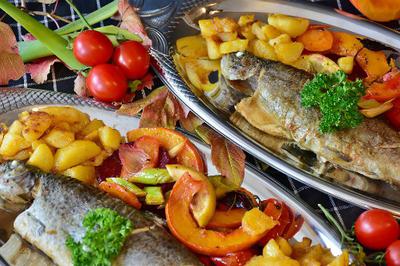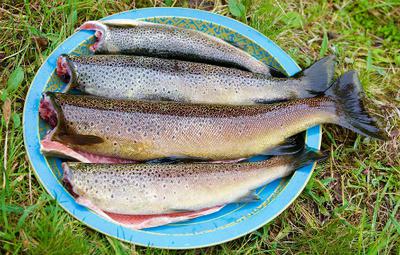Pan fried Titicaca rainbow trout

Bolivia may not have access to the sea but there is always delicious trout from Lake Titicaca. Along the drive to the lake and in Copacabana you can enjoy trout cooked in a variety of ways at the dozens of restaurants that line the lakeshore.
Lake Titicaca, at 3,812 m (12,500 ft) above sea level is the highest commercially navigable lake in the world. By volume of water it is also the largest lake in South America. Lake Titicaca lies on the border of Peru and Bolivia, with each country claiming ownership of roughly half the lake. On the Peruvian side, the lake averages 500-600 feet in depth, but on the Bolivian side reaches depths of over 900 feet.
Numerous rivers feed the lake waters. One small river, the Desaguadero, is Lake Titicaca's only outlet and it drains under 5% of the lake's excess waters. The rest is lost through evaporation. The lake level fluctuates, growing in volume during the rainy season and receding during the dry season.
Lake Titicaca is thought to be at least 2 million years old and it is believed its waters used to cover a much greater area, including the distant Uyuni Salt Flats. The lake doesn't have a great variety of fish and is also home to one of the world's largest frog species, the Telmatobius, which averages about a foot long, but has been found to reach up to two feet in length in deeper waters.
Trout were introduced into the lake in 1939 and today there is nothing more delicious than a big piping hot plate of Titicaca rainbow trout with rice and salad right on the lake shore. You can't get fresher than trout straight from the water to the grill to your plate, and the nippy cold weather makes enjoying hot grilled trout outside especially tasty!
Bolivia celebrates Día del Mar (Day of the Sea) on the 23rd of March each year. Even though Bolivia is a landlocked nation, it has a navy! You can see the Bolivian Naval Academy on the shores of Lake Titicaca.
The recipe for pan fried trout is super easy. The secret is in the starch. Let's see why:
Ingredients:
4 large whole rainbow trout, cleaned and with bones removed, but with the skin, heads and tails intact
1 cup of cornstarch**
1 tsp of Bolivian rose salt
1/2 tsp of black pepper
1 tsp ground cumin
1/4 cup of your preferred cooking oil
2 lemons, halved
** We use starch instead of flour because flour is too heavy. Starch will give your fried fish just the slightest dusting of deliciousness rather than a thick coating of flour, which can turn dough-y and clumpy when you fry it. You don't want a "breaded" fish. You just want to create a very thin layer of starch and spices on your fish, not cover up the flavor of the fish itself. Crispy trout skin has a great flavor!!
Instructions:
Mix all of your dry ingredients together. It's preferable that you sift them together, but you can mix them well with a whisk or fork.
Clean and remove the bones from your trout, but do not skin them. Honestly, they are normally served whole with the heads and tails intact, but if you are like me and you just can't eat something that is looking at you, cut the heads off.
If you choose to remove the fish heads, don't discard them. Bolivians make a delicious thin broth fish head soup that is marvelous and quite healthy. Freeze them instead and use them for that at another time. There is a lot of flavor in a fish head.
Back to our recipe. Pat any water drop that are left over on your fish from washing them, but do not remove all of the moisture from the fish or fish skin.
Roll the fish in the starch mixture until completely coated. With your hands, scoop some of the starch mixture and just glide some of it onto the inside of the fish as well. Take each fish by the tail, and give it a little shake to shake off any extra clumpy mixture.
What we are trying to create is a very, very thin crispy coating on the fish skin and flesh, so that when you eat the fish, it will be slightly crispy on the outside and wonderful and juicy on the inside. We don't want our fish to dry out when fried, and the coating of starch will prevent that from happening.
A large cast iron skillet is the best for this fried fish, but if you don't have one, you can use a large pan or electric skillet.
Add the oil to your pan and heat it until it is quite hot. Fry one fish at a time. Place the fish on one side into the pan until it is seared (about 1-2 minutes), then flip it over and sear the other side (another 1-2 minutes).
Reduce the heat. Fry your fish first on one side and then on the other until it is cooked through (about 10 minutes on each side). You can flip it several times if needed.
You can open the fish a bit to look inside to be sure it is cooked through. The flesh should be flaky.
Bolivians typically serve Titicaca rainbow trout with perfect Bolivian rice, thick flaky French fries or fried quartered potatoes, and a side salad.
Bolivians make the salad of only 3 vegetables: thinly shredded lettuce, thinly (very thinly) sliced purple onions, and diced tomatoes drizzled with the tiniest bit of oil and vinegar and a shake of salt.
If you like lemon on your fish (I don't) squeeze half a lemon onto each trout.
But you can serve your fish with anything you want. I find it is especially delicious with baked squash or zucchini.
Lake Titicaca, at 3,812 m (12,500 ft) above sea level is the highest commercially navigable lake in the world. By volume of water it is also the largest lake in South America. Lake Titicaca lies on the border of Peru and Bolivia, with each country claiming ownership of roughly half the lake. On the Peruvian side, the lake averages 500-600 feet in depth, but on the Bolivian side reaches depths of over 900 feet.
Numerous rivers feed the lake waters. One small river, the Desaguadero, is Lake Titicaca's only outlet and it drains under 5% of the lake's excess waters. The rest is lost through evaporation. The lake level fluctuates, growing in volume during the rainy season and receding during the dry season.
Lake Titicaca is thought to be at least 2 million years old and it is believed its waters used to cover a much greater area, including the distant Uyuni Salt Flats. The lake doesn't have a great variety of fish and is also home to one of the world's largest frog species, the Telmatobius, which averages about a foot long, but has been found to reach up to two feet in length in deeper waters.
Trout were introduced into the lake in 1939 and today there is nothing more delicious than a big piping hot plate of Titicaca rainbow trout with rice and salad right on the lake shore. You can't get fresher than trout straight from the water to the grill to your plate, and the nippy cold weather makes enjoying hot grilled trout outside especially tasty!
Bolivia celebrates Día del Mar (Day of the Sea) on the 23rd of March each year. Even though Bolivia is a landlocked nation, it has a navy! You can see the Bolivian Naval Academy on the shores of Lake Titicaca.
The recipe for pan fried trout is super easy. The secret is in the starch. Let's see why:
Ingredients:
4 large whole rainbow trout, cleaned and with bones removed, but with the skin, heads and tails intact
1 cup of cornstarch**
1 tsp of Bolivian rose salt
1/2 tsp of black pepper
1 tsp ground cumin
1/4 cup of your preferred cooking oil
2 lemons, halved
** We use starch instead of flour because flour is too heavy. Starch will give your fried fish just the slightest dusting of deliciousness rather than a thick coating of flour, which can turn dough-y and clumpy when you fry it. You don't want a "breaded" fish. You just want to create a very thin layer of starch and spices on your fish, not cover up the flavor of the fish itself. Crispy trout skin has a great flavor!!
Instructions:
Mix all of your dry ingredients together. It's preferable that you sift them together, but you can mix them well with a whisk or fork.
Clean and remove the bones from your trout, but do not skin them. Honestly, they are normally served whole with the heads and tails intact, but if you are like me and you just can't eat something that is looking at you, cut the heads off.
If you choose to remove the fish heads, don't discard them. Bolivians make a delicious thin broth fish head soup that is marvelous and quite healthy. Freeze them instead and use them for that at another time. There is a lot of flavor in a fish head.
Back to our recipe. Pat any water drop that are left over on your fish from washing them, but do not remove all of the moisture from the fish or fish skin.
Roll the fish in the starch mixture until completely coated. With your hands, scoop some of the starch mixture and just glide some of it onto the inside of the fish as well. Take each fish by the tail, and give it a little shake to shake off any extra clumpy mixture.
What we are trying to create is a very, very thin crispy coating on the fish skin and flesh, so that when you eat the fish, it will be slightly crispy on the outside and wonderful and juicy on the inside. We don't want our fish to dry out when fried, and the coating of starch will prevent that from happening.
A large cast iron skillet is the best for this fried fish, but if you don't have one, you can use a large pan or electric skillet.
Add the oil to your pan and heat it until it is quite hot. Fry one fish at a time. Place the fish on one side into the pan until it is seared (about 1-2 minutes), then flip it over and sear the other side (another 1-2 minutes).
Reduce the heat. Fry your fish first on one side and then on the other until it is cooked through (about 10 minutes on each side). You can flip it several times if needed.
You can open the fish a bit to look inside to be sure it is cooked through. The flesh should be flaky.
Bolivians typically serve Titicaca rainbow trout with perfect Bolivian rice, thick flaky French fries or fried quartered potatoes, and a side salad.
Bolivians make the salad of only 3 vegetables: thinly shredded lettuce, thinly (very thinly) sliced purple onions, and diced tomatoes drizzled with the tiniest bit of oil and vinegar and a shake of salt.
If you like lemon on your fish (I don't) squeeze half a lemon onto each trout.
But you can serve your fish with anything you want. I find it is especially delicious with baked squash or zucchini.
Join in and write your own page! It's easy to do. How? Simply click here to return to Bolivian Food.



